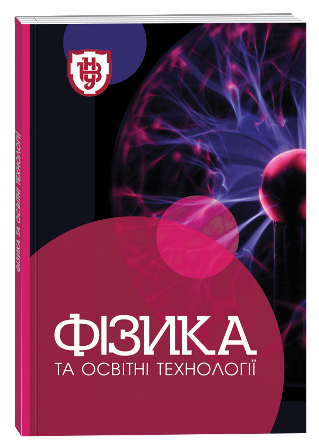OPTICAL PROPERTIES OF CRYSTALS (TlGaSe2)1-x(SnSe2)x
DOI:
https://doi.org/10.32782/pet-2025-1-3Keywords:
semiconductor, optical properties, band gap, absorption edge, Urbach’s ruleAbstract
The development of modern technologies requires the search for new promising materials as the main source of expanding and improving the functionality of semiconductor electronics devices. The scientific basis of such a search is the study of the physical properties of multicomponent systems, the study of the structure and properties of the identified phases.The potential that layered semiconductors open for the study of a number of new phenomena in solid-state physics is far from exhausted, and the interest of researchers in them is constantly growing. The properties of solid solutions based on Thallium chalcogenides make it possible to control their physical parameters and use them as detectors, optical analyzers, photo- and X-ray converters, and receivers of the visible and IR regions of the spectrum.Studies of the TlInSe2–SnSe2 system (Mozolyuk, 2011) indicate the formation of a wide range of solid solutions in the range of 0–28 mol.% SnSe2. For Tl1-xIn1-xSnxSe2 crystals (x=0; 0,1; 0,2; 0,25), the achieved values of the parameters of the third-order nonlinear optical effects are maximally critical, which allows us to predict their wide use as effective materials for nonlinear frequency conversion in the IR region of the spectrum, which is critical for IR lidar systems. Of particular interest may be their use in photonic gratings (Myronchuk, 2013).The family of binary compounds TlX (X= S, Se, Te) and their derivatives are well known as semiconductors for optical applications (Itoga, 1971). There are also ordered ternary representatives of TlTtX2 (Tt= Al, Ga, In) with two crystallographic centers with different coordination environments, but the existence of solid solutions for different chalcogenides cannot be excluded. Crystals (TlGaSe2)1-x(SnSe2)x (x=0,05; 0,1) were synthesized to increase the possibilities of controlling the physical properties of thallium-based compounds. This work presents the results of experimental studies of the optical properties of these compounds to understand their potential in optoelectronic and photonic devices.
References
Mozolyuk M. Yu., Piskach L. V., Fedorchuk A. O., Kityk I. V., Olekseyuk I. D., Parasyuk O. V. Phase diagram of the quasi-binary system TlInSe2–SnSe2. J. AlloysCompd. 2011. Vol. 509. P. 2693–2696.
Myronchuk G. L., Davydyuk G. E., Parasyuk O. V., Khyzhun O. Y., Andrievski R. A., Fedorchuk A. O., Danylchuk S. P., Piskach L. V., Mozolyuk M. Yu. Tl1-xIn1-xSnxSe2 (x = 0; 0,1; 0,2; 0,25) single-crystalline alloys as promising non-linear optical materials. Journal of Materials Science: Materials in Electronics. 2013. Vol. 24. P. 3555–3563.
Itoga R.S., Kannewurf C.R. Electrical resistivity, hall effect and optical absorption in TlS, TlS0.5Se0.5 and TlSe. J. Phys. Chem. Solids. 1971. Vol. 32. № 6. P. 1099–1110.
Pankove J. I. Optical Processes in Semiconductors, Prentice-Hall, New Jersey. 1971. 422 p.
Vytautas Grivickas, Vitalijus Bikbajevas, and Paulius Grivickas. Indirect absorption edge of TlGaSe2 crystals Phys. stat. sol. (b). 2006. Vol. 243. №. 5. P. R31–R33.
Simon Johnsen, Zhifu Liu, John A. Peters, Jung-Hwan Song, Sebastian C. Peter, Christos D. Malliakas, Nam Ki Cho, Hosub Jin, Arthur J. Freeman, Bruce W. Wessels, and Mercouri G. Kanatzidis. Thallium Chalcogenide-Based Wide-Band-Gap Semiconductors: TlGaSe2 for Radiation Detectors. Chem. Mater. 2011. Vol. 23. P. 3120–3128.
Mott N. F., Davis E. A. Electronic Processes in Non-Crystalline Materials, Oxford University Press, New York. 1971. 590 p.
Гулямов Г., Шарибаев Н. Ю. Влияние температуры на ширину запрещенной зоны полупроводника. Физическая инженерия поверхности. 2011. Т. 9. № 1. С. 40–43.
Myronchuk G. L., Zamurueva O. V., Parasyuk O. V., Piskach L. V., Fedorchuk A. O., AlZayed N. S., El-Naggar A. M., Ebothe J., Lis M., Kityk I. V. Structural and optical properties of novel optoelectronic Tl1-xIn1-xSixSe2 single crystals. J. Mater Sci: Mater Electron. 2014. Vol. 25. P. 3226–3232.
Davydyuk G. E., Piasecki M., Parasyuk O.V., Myronchuk G. L., Fedorchuk A. O., Danylchuk S. P., Piskach L. V., Mozolyuk M. Yu., AlZayed N., Kityk I. V. Twophoton absorption of Tl1-xIn1-xSnxSe2 (x=0, 0.1, 0.2, 0.25) single crystalline alloys and their nanocrystallites. Optical Materials. 2013. Vol. 35. P. 2514–2518.
Urbach F. The Long-Wavelength Edge of Photographie Sensitivity and of the Electronic Absorption of Solids. Phys. Rev. 1953. Vol. 92. № 5. P. 1324–1324.
Yang Z., Homewood K. P., Finney M. S., Harry M. A., Reeson K. J. Optical absorption study of ion beam synthesized polycrystalline semiconducting FeSi2. J. Appl. Phys. 1995. Vol. 78. № 3. P. 1958–1963.
Beaudoin M., DeVries A. J. G., Johnson S. R., Laman H., Tiedje T. Optical absorption edge of semi-insulating GaAs and InP at high temperatures. Appl. Phys. Lett. 1997. Vol. 70. P. 3540–3542.
Kurik, M. V. (1971). Urbach rule. Phys. Status Solidi A., 8, 9–30.
Kurik, M. V. (1991). Experimental evaluation of exciton-phonon interaction constant. Fiz. Tverd. Tela., 33, 615–618.
Piasecki M., Myronchuk G. L., Zamurueva O. V., Khyzhun O. Y., Parasyuk O. V., Fedorchuk A. O., Albassam A., El-Naggar, Kityk A. M., I. V. Huge Operation by Energy Gap of Novel Narrow Band Gap Tl1-xIn1-xBxSe2 (B = Si, Ge): DFT, X-ray Emission and Photoconductivity Studies. Mater. Res. Express. 2016. Vol. 3. № 2. P. 025902.
Paucar R., Itsuwa H., Wakita K., Shim Y., Alekperov O., Mamedov N. Phase transitionsand Raman scattering spectra of TlGaSe2. Journal of Physics: Conference Series. 2015. Vol. 619 P. 012018.
Abay B., Güder H. S., Efeoğlu H., Yoğurtçu Y. K. Temperature dependence of the optical energy gap and Urbach-Martienssen’s tail in the absorption spectra of the layered semiconductor Tl2GaInSe4. J. Phys. Chem. Solids. 2001. Vol. 62. P. 747–752.








